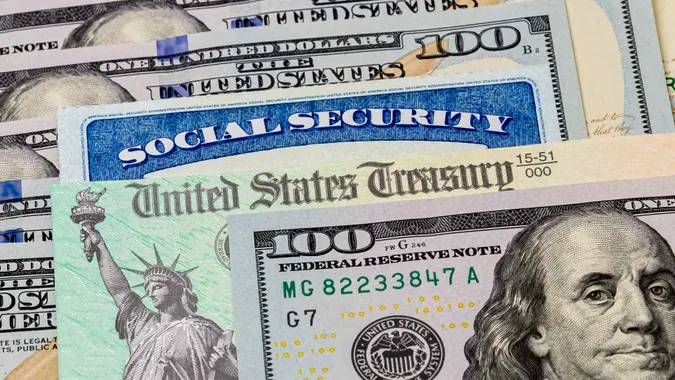10 Expert-Approved Strategies Retirees Are Using To Beat 3% Inflation Now

Commitment to Our Readers
GOBankingRates' editorial team is committed to bringing you unbiased reviews and information. We use data-driven methodologies to evaluate financial products and services - our reviews and ratings are not influenced by advertisers. You can read more about our editorial guidelines and our products and services review methodology.

20 Years
Helping You Live Richer

Reviewed
by Experts

Trusted by
Millions of Readers
Inflation has crept up again, hovering around 3%, which is higher than the Federal Reserve would like. For retirees, that means higher prices on everything from groceries to healthcare.
Some retirees are choosing to weather this inflationary wave by adjusting habits and using smart financial strategies. Here’s how they’re keeping their savings strong — and how you can, too.
1. Practicing Good Budgeting Habits
Retirees staying ahead of inflation are reviewing their budgets, prioritizing essential expenses and trimming discretionary spending, according to Christopher Stroup, a CFP and owner of Silicon Beach Financial. Big savings often come from small adjustments, like monitoring utility use or consolidating subscriptions, which frees cash for inflation-protected investments or unexpected costs.
“Combining this with tax-efficient withdrawals and strategic asset allocation helps money last longer,” Stroup said.
Vivian Tu:
2. Looking Beyond Standard Checking
Retirees with strong financial habits don’t leave money sitting in basic checking accounts, Stroup said. Instead, they turn to high-yield savings accounts, short-term CDs and Treasury bills, all of which offer low-risk ways to grow cash faster than traditional accounts.
“[They] act as safe liquidity buffers, providing better returns than traditional accounts without risking principal,” he said.
Laddering CDs or Treasury maturities — staggering investment end dates — can also provide steady interest income while keeping funds accessible for short-term needs.
3. Focusing on Strategic Investments
Retirees maintaining healthy returns are often invested in Treasury Inflation-Protected Securities (TIPS), inflation-focused bond funds and dividend-growing equities, Stroup said. These assets help maintain purchasing power.
“Balanced exposure — combining income-generating assets with inflation-sensitive growth investments — helps retirees weather moderate inflation without excessive market risk,” he explained.
Dividend-growth stocks also play a key role, said Doug Carey, chartered financial analyst and founder of WealthTrace. “These are companies with a long history of raising dividends without ever cutting them. A growing dividend stream is a fantastic way to have stable income in retirement and beat inflation.”
4. Reassessing Withdrawal Rates
Financially secure retirees reassess their withdrawal rates each year, factoring in inflation, portfolio returns and unexpected expenses, Stroup said. “Even a small reduction combined with tax-efficient withdrawals can preserve capital over the long term and prevent depletion of retirement assets during moderate inflation periods.”
5. Delaying Social Security
Another smart inflation strategy is delaying Social Security, Carey said. For every year you delay beyond your full retirement age, your benefit increases by about 8%.
“Life expectancy is important here though,” Carey pointed out. “The break-even age for most people is 78 years old in terms of how long they must live to recoup the lost years of missed Social Security payments.”
6. Paying Off High-Interest Debt
Retirees with the most financial freedom have either paid off or are actively paying down high-interest debt such as credit cards, personal loans and adjustable-rate debt, Stroup said.
“Low-interest debt, like fixed-rate mortgages, may be less urgent during moderate inflation, as investment returns could exceed interest costs,” he noted. A balanced approach tailored to individual cash flow and risk tolerance is key.
7. Shopping Around for Healthcare
Healthcare costs can take a big bite out of retirement income, but savvy retirees shop around. Stroup advised comparing Medicare supplements, Part D drug plans and health savings account (HSA) options each year.
“Bundling insurance, evaluating in-network providers and reviewing preventative care options helps control costs while maintaining coverage in a rising-price environment,” he said.
8. Making Creative Living Arrangements
While many retirees downsize to lower housing costs, others get more creative. Stroup said that shared-living arrangements or co-housing communities can help retirees split housing, utility and transportation expenses.
“Others use bartering skills, multi-generational housing or vacation rentals to generate supplemental income,” he said. “Creative approaches like these preserve lifestyle while stretching fixed retirement dollars further.”
9. Adopting Smart Tax Strategies
A growing number of retirees are making Roth conversions, which Carey said “can save thousands of dollars if done right.” Converting in lower-tax years means future required minimum distributions (RMDs) are taxed at lower rates.
Carey also recommended withdrawing from taxable accounts first, delaying IRA withdrawals or blending Roth withdrawals to manage brackets efficiently.
10. Making Smart Everyday Moves
Finally, small lifestyle adjustments go a long way. Stroup said retirees who track recurring expenses, buy in bulk, meal plan, use public transportation and limit luxury subscriptions can stay ahead of rising costs.
“Even small lifestyle tweaks compound over time, helping retirees maintain comfort while inflation slowly erodes purchasing power,” he said.
Inflation may not be disappearing anytime soon, but retirees who stay flexible, proactive and strategic are finding ways to preserve their lifestyle without depleting their savings.
 Written by
Written by  Edited by
Edited by 

























